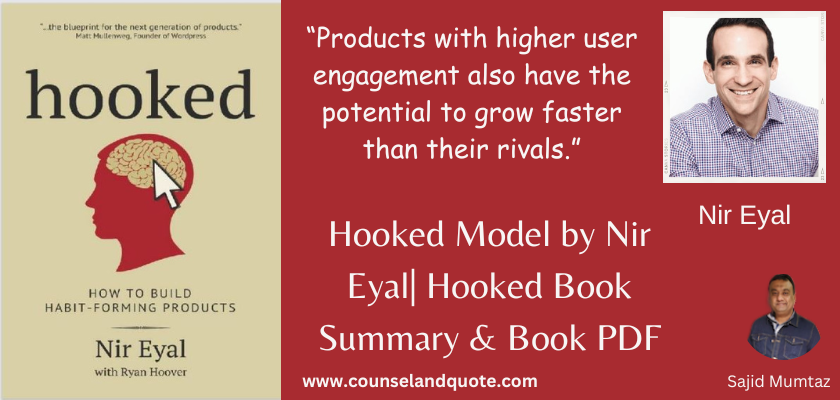Hooked Model by Nir Eyal is taken from his book “Hooked: How to Build Habit-Forming Products.” This article gives you the core message or summary of the book in very simple language.
The core messages of the book Hooked and the Hooked Model by Nir Eyal revolve around a four-step framework. These 4 steps are called the “Hook Model.
Step 1- Trigger Phase
Step 2- Action Phase
Step 3- Reward Phase (Variable Reward)
Step 4- Investment Phase
Download three recommended complete books only for you in the last section of the article. Get their PDFs. These are rare books and are shared for free.
[Also Read: The mind and thoughts of Nir Eyal]
Table of Contents
Why this Book- Hooked: How to Build Habit-Forming Products & Hooked Model by Nir Eyal?
Why this Book- Hooked: How to Build Habit-Forming Products & Hooked Model by Nir Eyal?
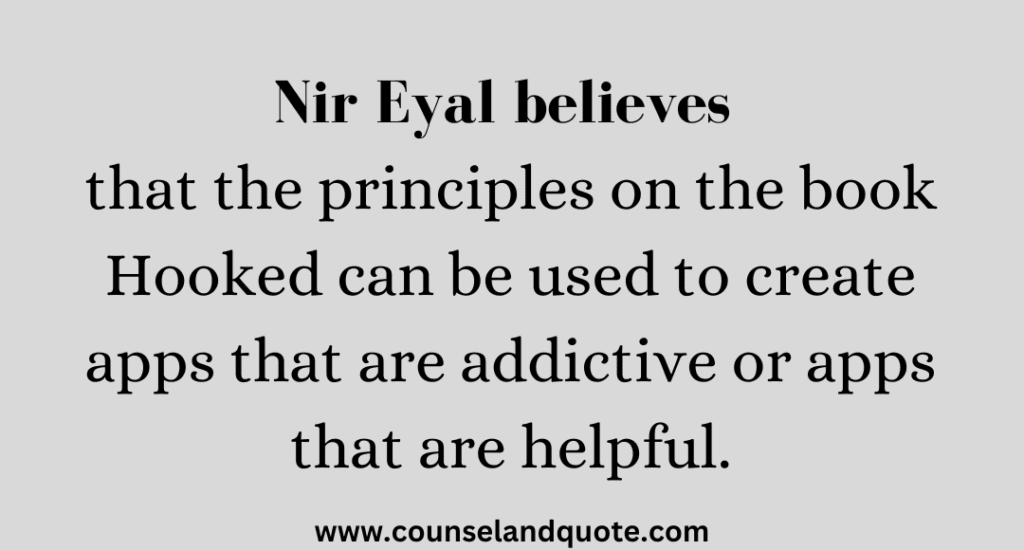
The book is written with a focus on product design and its principles are valuable for a broader audience interested in understanding human behavior, consumer psychology, and the impact of technology on our daily lives.
Readers, entrepreneurs, leaders, thinkers, psychologists and promoters looking to gain a deeper understanding of why certain products become habit-forming and how to apply these principles to their own projects may find “Hooked” to be a useful resource.”
How Does Nir Eyal Hooked Model Impact Us?
This Nir Eyal Hooked Model is elaborated here in the book summary. It plays in our minds and impacts our behaviour both positively and negatively.
Hooked Nir Eyal Positive Impacts
These impacts mainly make us engaged with the product and we benefit from it.
Increased engagement, improved user experience and business success by using the product are the positive impacts of this model.
Hooked Nir Eyal Negative Impacts
There are a few notable negative impacts of the model. A selfish producer or promoter may create a campaign to negatively impact us in their product and squeeze desired benefits.
Overuse and addiction to the product, distracted behaviours and privacy concerns are the primary alarming points that may negatively impact us.
Hooked Model by Nir Eyal & Hooked Book Summary/ What are the Principles of Hooked Model?
Hooked Model by Nir Eyal works in 4 steps. This hooked book summary explains the gist.
Step 1- Trigger
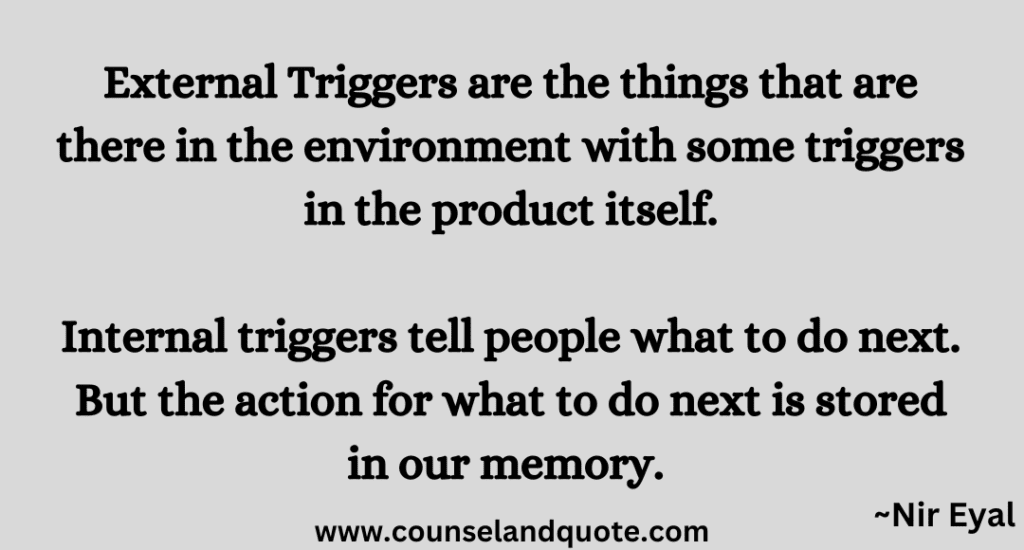
A trigger is a thing which tells us what to do next.
Triggers are of two types.
A- External Triggers- External triggers mainly affect us from outside, like our responses after getting a notification or watching an advertisement.
External Triggers are the things that are there in the environment with some triggers in the product itself.
B- Internal Triggers- Internal triggers mainly impact our emotions and thoughts.
These are the powerful long-term habit-formation activities that mould our behaviour and thought patterns. They make long-term associations with our thoughts.
Internal triggers tell people what to do next. But the action for what to do next is stored in our memory.
These internal triggers are mainly our specific emotions and they are our negative emotions. Negative emotions like feeling bored, uncertain, fatigued, fearful, lonely, dissatisfied, depressed, etc are more commonly influenced by internal triggers.
These negative emotions prompt us to act. They prompt us to pick our smartphones with no conscious thoughts.
When we are down with these negative emotions, we pick up our phones or electronic devices more often, just to change our feelings.
There is only one reason people use your product or any product. The reason is to modulate our mood or change our feelings.
It is why we go unconsciously to Facebook, YouTube, Google, Instagram, Snapchat, etc to change our mood. Before we think about why we are using our phones(products), we automatically use them. Because we are hooked to these products they become our habits.
The internal triggers of any product occur multiple times to form a habit. The frequency of occurrence must be at least once a week to build a habit.
So the product and its campaign are designed in such a way that it becomes a part of you so that you can be addicted to them.
It’s why we are so addicted to our smartphones and social media platforms.
A study reveals that we watch the home screen of our mobile close to 150 times a day. It is a clear-cut example of a hook in a product and its addictiveness.
Step 2- Action Phase
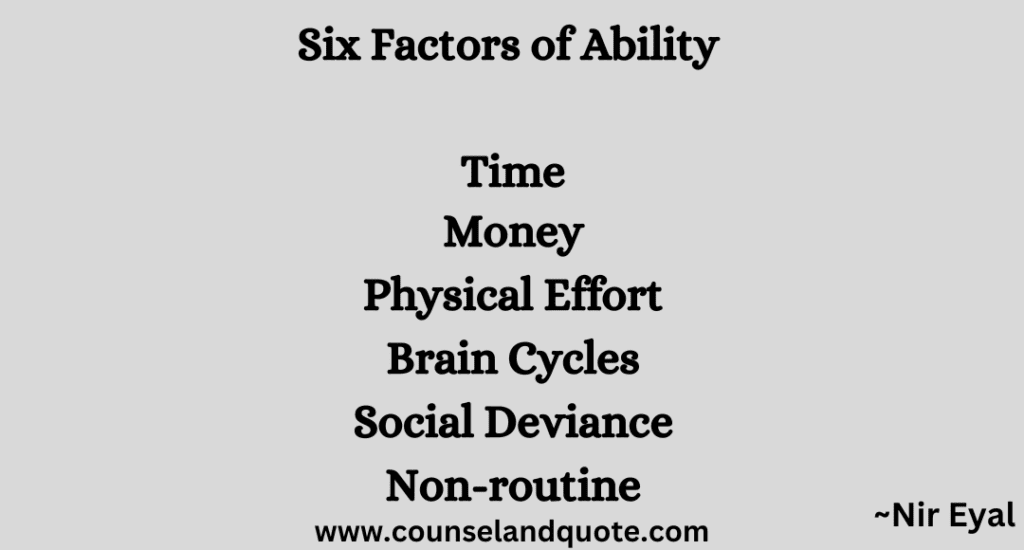
Nir Eyal says the action phase is defined as the simplest behaviour done in anticipation of a reward. The user feels to satisfy this need by taking the action.
An example of this kind of behaviour is scrolling various social media platforms like Facebook, Pinterest, Instagram, etc. Searches on Google or pushing the play button on YouTube are other examples of taking action for immediate rewards.
The simplest thing the user does is to satisfy the urge or itch.
The simplest thing the user does is to satisfy the urge or itch.
A Stanford researcher BJ Fogg says that for any singular behaviour to occur, we need 3 things at a time.
A- Sufficient Motivation– Energy for action (How much intensity we feel to make any action)
B- Capacity or Ability– Ability to take that action or how easy it is to make that step
C- Trigger– Strong urge to do something
Only motivation is not enough to make a particular behaviour occur in us. The Ability or Capacity to do that thing is more important.
The ability to do that activity is very important. Because it is responsible for our behaviour and habit formation.
Six Factors of Ability
There are six factors which prompt the behaviour.
1- Time– Decrease the time factor between the motivation and the action.
2- Money– Decrease the amount of money required to make that action
3- Physical Effort– Decrease the level of physical effort to take that action
4- Brain Cycles– Brain cycles are important. The harder something to learn or act, the tougher it is to convert into a behaviour
5- Social Deviance– People do something more easily when they see other people do the same thing
6- Non-routine– We are more likely to do something simply because we have done it in the past before
These six factors are responsible for our actions. They make our habits. What we do more often becomes a part of our habit.
When something becomes our habit, it becomes easier to do and repeat. We give it the name of practice. Habits have this repeat effect.
3- Reward Phase- Variable Rewards (Scratch the itch)
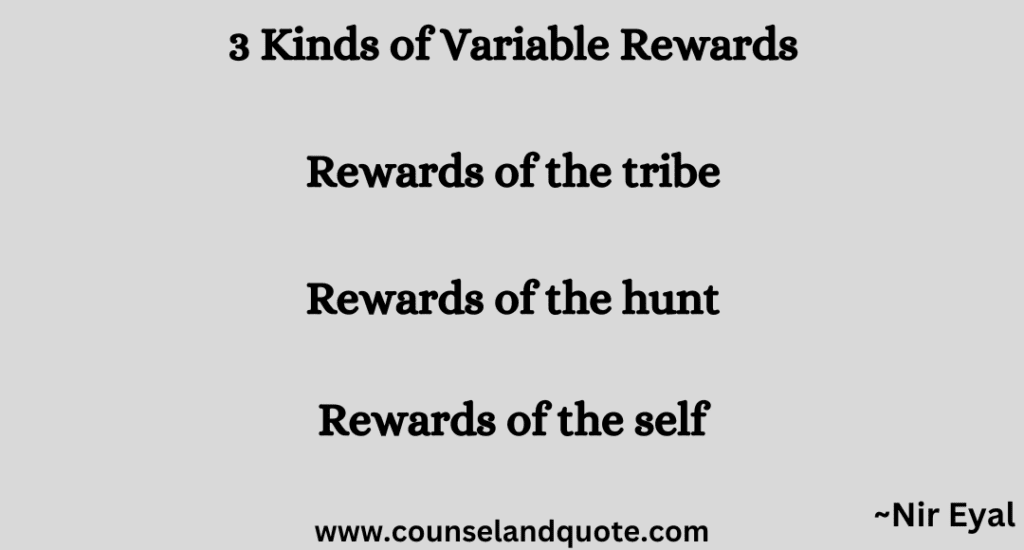
It is not enough to give people what they want. But it is more important to leave people at a stage where they want to have more and more of it.
It is done by using the psychology of ‘Variable Rewards.’
Variable Rewards- It is the work analysis of the psychologist B.F. Skinner. He experimented with his test on pigeons and created an operant conditioning chamber.
He took hungry pigeons in a cage and gave them a liver to peck at for food.
The hunger was the trigger to peck at the liver. Whenever these pigeons peck at this disk they get the reward in the form of food pellettes.
This became the behaviour of pigeons.
Whenever they felt hungry they would hit the disk button for food. When they are satiated they never hit the disk.
Then, BF Skinner did something different in his experiment. He introduced the concept of variable rewards in his test.
Now, these pigeons would get the food by pecking at the food with variable possibilities.
Sometimes these pigeons would peck at the button, they get the food and sometimes nothing would come out. So the coming out of food pellets became uncertain.
B.F. Skinner observed that the rate of response to hit the disk button to receive food pellets increased.
Pigeons would hit more frequently to get the feed.
The variable reward system raised the pecking.
Why did it happen?
B.F. Skinner concluded that the variability or uncertainty spiked the reward system in our brains. It created more wanting and desire.
Companies use this psychology to create products. They create more engaging, more habit-forming products to capture your attention. Their usage leaves us wanting more and more and we repeat them.
There are three kinds of Variable Rewards.
A- Rewards of the tribe– Variability or uncertainty coming from other people, like cooperation, romance, competition, comparison, etc.
Feeling joyous and happy because others are also happy. These all things have variability and uncertainty.
B- Rewards of the hunt– It resembles our primal needs for food and other material possessions. We get them in our modern world with money.
We search and search or scroll and scroll for the next hunt. Finding more and more of them, we keep on doing.
C- Rewards of the self– It is something which makes us feel good with a sense of variability. It doesn’t come from other people or things. It comes from within us, what we want and like.
It comes from the thought of gaining mastery, competency, consistency, and control.
Video game playing is a solid example of it. Getting to the next level and accomplishing more and more is the trigger behind these actions.
Step 4- Investment Phase
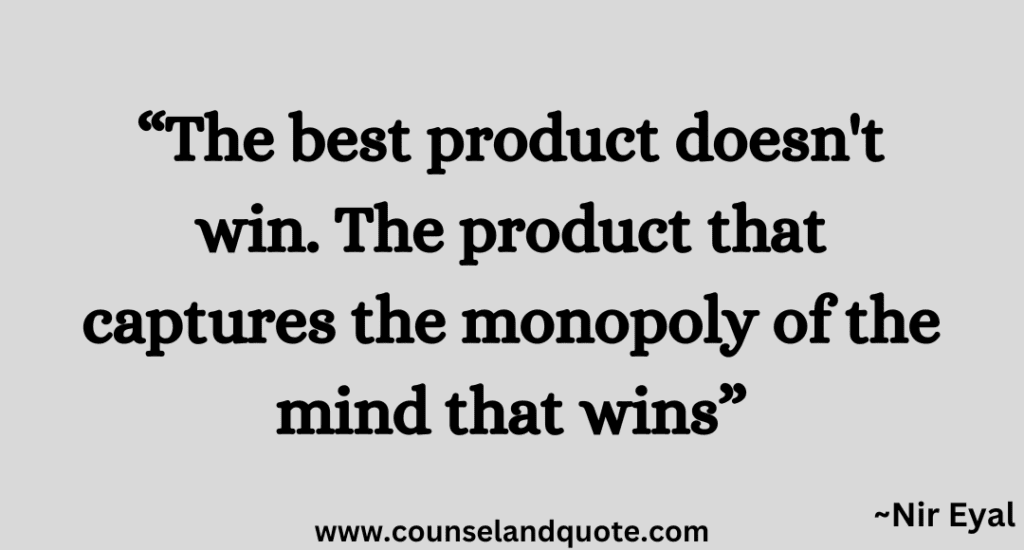
In this investment phase user puts something in the product in anticipation of a future reward. It is not about immediate gratification but about future benefits.
The purpose of the investment is to increase the likelihood of the next pass through the hook. It serves the purpose in two ways.
A- It loads the next trigger– It means you get a new trigger, action, reward, and investment cycle and it goes on and on and on.
B- Storing Value– Everything in the physical world loses value with the wear and tear of usage. Habit-forming products do the opposite. They appreciate the usage.
They make us feel better and better and we become more engaging with them.
Social media products like Snapchat, Facebook, Instagram, YouTube, Google, etc give us likes, friends, content, followers, and appreciation to name a few to make us addicted to them.
They customize the product and make it harder to leave them.
The best product doesn’t win. The product that captures the monopoly of the mind that wins- Nir Eyal
Buy the Book on Amazon
This world-famous book is available on most of the platforms. It is a highly rated, thought-provoking material for those who want to achieve big in life.
| Book Name | Hooked: How to Build Habit-Forming Products |
| Author | Nir Eyal |
| Language | English |
| Book Rating | 4.5/5 |
| Pages | 169 |
| Publisher | Business Books |
| Price | $21.16 |
| Book on Amazon | Get the Book |
Download the Book Hooked: How to Build Habit-Forming Products Free PDF
The download button is given below.

Click the button and get the book.
Three Recommended Books for you
1- 12 Brain Rules by John Medina
The Download button for the book “Brain Rules” is given below.
Press the button and download the book.
A master memory book by a memory expert.
This book can train your brain and bring abundance to life. Get the book by pressing the download button.
3- The Miracle Morning Book by Hal Elrod
A great book to cultivate the best habits in you. This book can bring out the best in you.
Read this complete book to transform your habits and life.
Conclusion
Hooked Model by Nir Eyal is shared here from the book Hooked: How to Build Habit-Forming Products.
The merits and demerits of the model are also shared. The complete PDF of the Hooked is given to readers and book lovers.
Three more books are recommended and their complete PDFs are shared.
Download these books and share them with your friends and relatives.
These books and their lessons may help everyone a lot.
May God Bless You. Amen.
Thank you.
